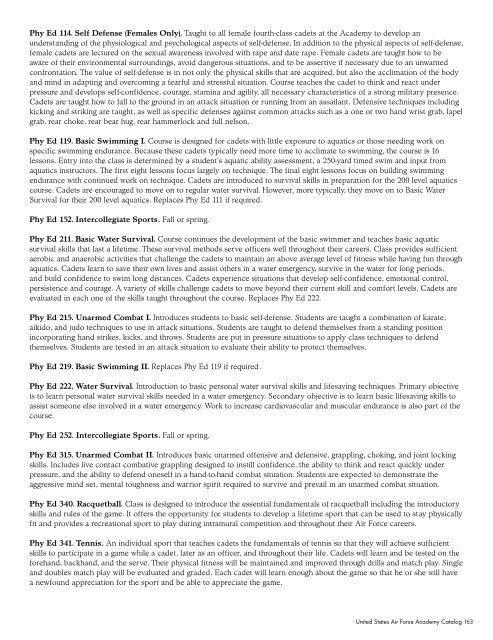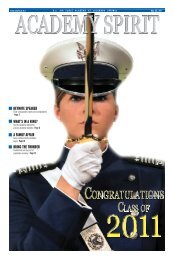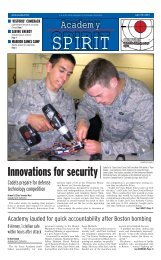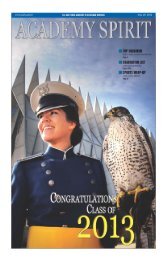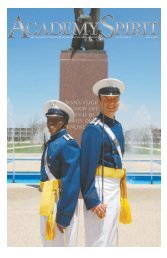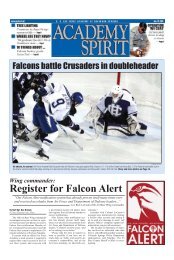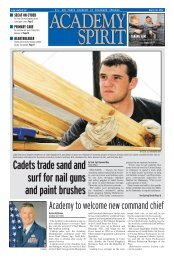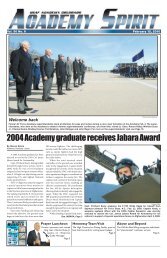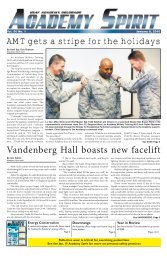2008-2009 Catalog - United States Air Force Academy
2008-2009 Catalog - United States Air Force Academy
2008-2009 Catalog - United States Air Force Academy
Create successful ePaper yourself
Turn your PDF publications into a flip-book with our unique Google optimized e-Paper software.
Phy Ed 114. Self Defense (Females Only). Taught to all female fourth-class cadets at the <strong>Academy</strong> to develop an<br />
understanding of the physiological and psychological aspects of self-defense. In addition to the physical aspects of self-defense,<br />
female cadets are lectured on the sexual awareness involved with rape and date rape. Female cadets are taught how to be<br />
aware of their environmental surroundings, avoid dangerous situations, and to be assertive if necessary due to an unwanted<br />
confrontation. The value of self-defense is in not only the physical skills that are acquired, but also the acclimation of the body<br />
and mind in adapting and overcoming a fearful and stressful situation. Course teaches the cadet to think and react under<br />
pressure and develops self-confidence, courage, stamina and agility, all necessary characteristics of a strong military presence.<br />
Cadets are taught how to fall to the ground in an attack situation or running from an assailant. Defensive techniques including<br />
kicking and striking are taught, as well as specific defenses against common attacks such as a one or two hand wrist grab, lapel<br />
grab, rear choke, rear bear hug, rear hammerlock and full nelson.<br />
Phy Ed 119. Basic Swimming I. Course is designed for cadets with little exposure to aquatics or those needing work on<br />
specific swimming endurance. Because these cadets typically need more time to acclimate to swimming, the course is 16<br />
lessons. Entry into the class is determined by a student’s aquatic ability assessment, a 250-yard timed swim and input from<br />
aquatics instructors. The first eight lessons focus largely on technique. The final eight lessons focus on building swimming<br />
endurance with continued work on technique. Cadets are introduced to survival skills in preparation for the 200 level aquatics<br />
course. Cadets are encouraged to move on to regular water survival. However, more typically, they move on to Basic Water<br />
Survival for their 200 level aquatics. Replaces Phy Ed 111 if required.<br />
Phy Ed 152. Intercollegiate Sports. Fall or spring.<br />
Phy Ed 211. Basic Water Survival. Course continues the development of the basic swimmer and teaches basic aquatic<br />
survival skills that last a lifetime. These survival methods serve officers well throughout their careers. Class provides sufficient<br />
aerobic and anaerobic activities that challenge the cadets to maintain an above average level of fitness while having fun through<br />
aquatics. Cadets learn to save their own lives and assist others in a water emergency, survive in the water for long periods,<br />
and build confidence to swim long distances. Cadets experience situations that develop self-confidence, emotional control,<br />
persistence and courage. A variety of skills challenge cadets to move beyond their current skill and comfort levels. Cadets are<br />
evaluated in each one of the skills taught throughout the course. Replaces Phy Ed 222.<br />
Phy Ed 215. Unarmed Combat I. Introduces students to basic self-defense. Students are taught a combination of karate,<br />
aikido, and judo techniques to use in attack situations. Students are taught to defend themselves from a standing position<br />
incorporating hand strikes, kicks, and throws. Students are put in pressure situations to apply class techniques to defend<br />
themselves. Students are tested in an attack situation to evaluate their ability to protect themselves.<br />
Phy Ed 219. Basic Swimming II. Replaces Phy Ed 119 if required.<br />
Phy Ed 222. Water Survival. Introduction to basic personal water survival skills and lifesaving techniques. Primary objective<br />
is to learn personal water survival skills needed in a water emergency. Secondary objective is to learn basic lifesaving skills to<br />
assist someone else involved in a water emergency. Work to increase cardiovascular and muscular endurance is also part of the<br />
course.<br />
Phy Ed 252. Intercollegiate Sports. Fall or spring.<br />
Phy Ed 315. Unarmed Combat II. Introduces basic unarmed offensive and defensive, grappling, choking, and joint locking<br />
skills. Includes live contact combative grappling designed to instill confidence, the ability to think and react quickly under<br />
pressure, and the ability to defend oneself in a hand-to-hand combat situation. Students are expected to demonstrate the<br />
aggressive mind set, mental toughness and warrior spirit required to survive and prevail in an unarmed combat situation.<br />
Phy Ed 340. Racquetball. Class is designed to introduce the essential fundamentals of racquetball including the introductory<br />
skills and rules of the game. It offers the opportunity for students to develop a lifetime sport that can be used to stay physically<br />
fit and provides a recreational sport to play during intramural competition and throughout their <strong>Air</strong> <strong>Force</strong> careers.<br />
Phy Ed 341. Tennis. An individual sport that teaches cadets the fundamentals of tennis so that they will achieve sufficient<br />
skills to participate in a game while a cadet, later as an officer, and throughout their life. Cadets will learn and be tested on the<br />
forehand, backhand, and the serve. Their physical fitness will be maintained and improved through drills and match play. Single<br />
and doubles match play will be evaluated and graded. Each cadet will learn enough about the game so that he or she will have<br />
a newfound appreciation for the sport and be able to appreciate the game.<br />
<strong>United</strong> <strong>States</strong> <strong>Air</strong> <strong>Force</strong> <strong>Academy</strong> <strong>Catalog</strong> 163


